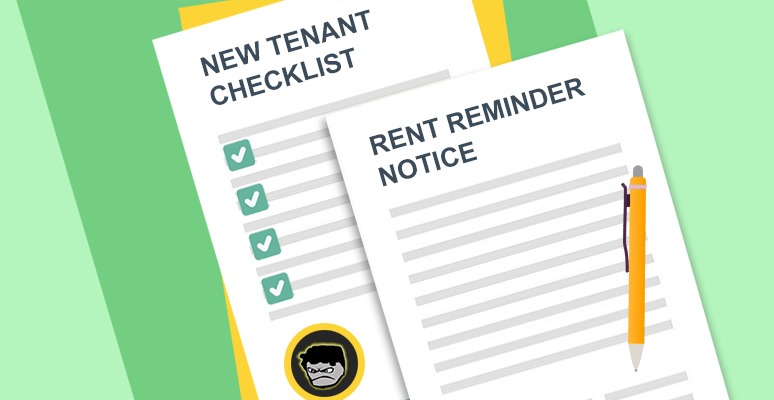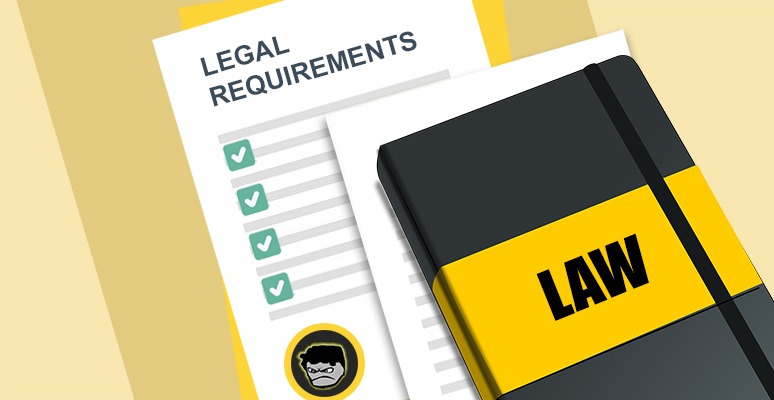
Want FREE legal advice on how to end your tenancy the right way?
Before I get into this blog post (which I think you should read regardless of this offer), I just want to make you aware of the exclusive deal I’ve managed to arrange with one of the leading landlord legal specialists in the country, LegalforLandlords – they have agreed to give Property Investment Project followers free legal advice (no obligations) and special discounted rates (if you choose to use their services)!
LegalforLandlords can help landlords with every aspect of ending a tenancy the right way, even if you have problem tenants that require evicting.
Well, this was bound to happen, wasn’t it?
Covering the topic of how to end a tenancy agreement seems like natural progression after blogging about how to renew a tenancy agreement.
Granted, both topics equally as unfulfilling to write (and probably to read if it’s not relevant to your current needs) as each other, but undeniably important and inevitable steps of being a landlord.
That said, I’m not just following the natural order of progression, because cutting ties with a tenant was something I recently had to deal with, so there is a hint of unchoreographed coincidence and relevance to this follow-up blog post.
Anyways, let’s get to it, here’s a guide on how to end / terminate a tenancy agreement the right way.
Page contents
- IMPORTANT: End your Tenancy Agreement the right way!
- Different ways of Ending a Tenancy
- Few final points/tips
IMPORTANT: End your Tenancy Agreement the right way!
Ending a tenancy agreement may seem like an easy process. Actually, to be fair, it is a relatively simple process, but it’s usually not as easy as many landlords would hope, and that’s why many terminations aren’t legit. Or to put it more accurately, in many cases, the method(s) used could be successfully disputed in court if it was to be challenged by a tenant because the proper procedures weren’t followed by the landlord. In that situation, the landlord could unwillingly find them self attached to an excruciatingly annoying occupant that has legal rights to stay put, along with a hefty legal bill. Lose/lose situation.
Despite popular belief, and as difficult as it may be to appreciate at times, a tenancy should be terminated/ended through the correct legal procedures. While that may not always be the most desirable of methods, especially when you’re dealing with unscrupulous, shit-for-brains tenants that are scamming the system and refusing to leave, it is still better advised to bow down and play by the rules in order to avoid a train wreck.
I can’t emphasise enough how important it is to handle the termination of tenancies the right way, in order to avoid potentially long and painful delays.
Different ways of Ending a Tenancy
1) Section 21 – Serving a possession order
This is the most common method of ending an assured shorthold tenancy, but I also think people, especially novice landlords and tenants, get confused by what a “possession notice” is.
A landlord has a legal right to repossess his/her property at the end of an assured shorthold tenancy, which is the end date specified in a tenancy agreement. For this to happen, the landlord is required to give the tenant appropriate notice by serving a Section 21 notice (under Section 21 of the Housing Act 1988).
A section 21 is NOT necessarily an eviction notice served when a tenant has done something wrong, it’s simply a notice to inform the tenant that the landlord wishes to take their property back. The landlord does not need to provide a reason for repossessing their property. However, the notice does not have the authority to end a tenancy during the fixed term – the landlord and tenant are both legally obligated to see through the tenancy terms.
It is important to note that a tenant legally requires a minimum of 2 months’ written notice from the landlord if they wish to end the tenancy. So if the end date in the tenancy agreement is 21st March 2019, and the landlord wishes to repossess the property on that date, a notice needs to be received by the tenant before 21st January 2019.
Ending/Terminating a Periodic Tenancy
If you wish to end a Periodic Tenancy (i.e. typically a rolling month-by-month contract, which automatically takes effect after the ‘fixed term’ expires where no new contract is signed), you can also serve a Section 21 notice to end the tenancy.
There is a small nuance when it comes to periodic tenancies and serving a section 21 notice:
- If you have a “Statutory Periodic Agreement” any break clause included in the original tenancy agreement becomes invalidated. A minimum of 2 months notice is required.
- If you have a “Contractual Periodic Tenancy” you should follow the relevant notice period set out in the original tenancy agreement.
If you’re not sure what the hell you have, allow my guide on periodic tenancies to shed some light on the matter.
2) Tenancy Surrender
I guess this is the opposite of a section 21 notice, kinda’. Instead of the landlord serving notice, the tenant is choosing to initiate the departure, via a surrender notice (notice to quit). Basically, the tenant is informing the landlord they wish to surrender the tenancy and vacate on said date.
A tenant can surrender their tenancy at the end of the tenancy or during a periodic tenancy, but they must give the landlord 1 months notice (the amount of notice required to be given during a periodic tenancy may differ). If a tenant wishes to vacate on the end date specified in the tenancy agreement, assuming the end date is 21st March 2019, the tenant should ensure the notice is received by the landlord before 21st February 2019.
3) Mutual agreement
A mutual agreement can be exercised at any point during a tenancy. it’s when both landlord and tenant agree to end the tenancy. Ultimately, a “mutual agreement” to terminate a tenancy can be agreed upon from 1 day into a tenancy. It happens.
From my experience, mutual agreements are exercised when a tenant requests to vacate during the fixed term, and the landlord obliges without putting up a fight.
I’ve said the following a few times before, but I’ll say it again because I think it’s an important message: if a tenant wants to leave, it’s usually best just to mutually end the tenancy, as opposed to putting up a pointless fight and hopelessly exasperating yourself.
The stress of going through that experience probably won’t be worth the outcome, which is usually a sour relationship, but more worryingly, a hostile tenant that feels entrapped in your property. If that isn’t a recipe for a disaster in the form of a tenant using your carpet as toilet paper and a cum-rag, I don’t know what is.
4) Section 8 – Tenant eviction
The crudest method of ending a tenancy agreement, and something we all want to avoid like genital herpes.
If at any point a landlord has grounds to evict a tenant, they can start the eviction process by serving a section 8 eviction notice. The most common reason for eviction is probably rent arrears.
Serving a section 8 should mostly be the last option because going down this path can be long and complicated if the tenant chooses not to vacate on request of the notice. Before serving the notice, it’s worth trying to get your tenant to surrender the tenancy or try to salvage a mutual agreement. Of course, it’s not always as easy as that, some times tenants simply don’t want to play ball. That’s when a sledgehammer is useful.
A section 8 can be served at any point during a tenancy, but in many cases it’s easier and more practical to serve a Section 21 to get rid of a rogue tenant. The reason being is that a Section 8 doesn’t guarantee eviction/possession. A tenant may choose to ignore the notice and remain in the property and then the case may inevitably end up in court for the Judge to decide your fate. Regrettably, the outcome may not be in your favour, and consequently side with the tenant and grant them rights to remain in the property. Essentially, the entire situation could drag on for several months and you may not even get the desired outcome. I’ve never been in this situation, but it happens, and I imagine it’s truly soul-destroying.
However, as mentioned, a landlord has a legal right to repossess their property at the end of the tenancy (the end date specified in the tenancy agreement). So depending on what stage the tenancy is at, particularly if it’s approaching the end date, or in a periodic tenancy, it might be worth going down the section 21 route instead, because the landlord will automatically be granted possessions, no questions asked (assuming the Section 21 was served under the right circumstances).
On a side note, it’s worth noting that you can serve both a section 21 and 8 at the same time, and see which one takes effect the quickest. They’re totally independent notices, served for very distinct reasons (although, with the intent of having the same outcome).
5) Break clauses
Some tenancy agreements have ‘break clauses’, which permits the landlord and tenant have the opportunity to end the tenancy agreement early. I personally don’t understand the point of break clauses because if you’re going to have one of those, you may as well just have a 6 month tenancy agreement (that’s the minimum length an assured shorthold tenancy can be). In any case, the terms and conditions of the break clause often depends on the clauses stipulated in the tenancy agreement.
Typically, the tenant or the landlord can serve notice (usually 2 months notice is required) during the fixed-term of the tenancy to end the tenancy early. The most common example where a break clause is used, is within a 12 month contract, which allows for the opportunity to end the tenancy after 6 months. Essentially, either party can “break” the tenancy before the end date, as long as the correct procedures are followed.
Again, a landlord should serve a section 21 notice and the tenant should send a surrender notice (depending on who wants to take advantage of the break clause). More details available in the tenancy break clause blog post.
Few final points/tips…
- Serving notices alone won’t end/terminate a tenancy, they’re only requesting for the tenancy to end. A tenancy has only ended when a tenant has officially vacated and returned the keys. In the case of stubborn tenants, a court order may be required to get a possession order.
Despite which method you use to terminate a tenancy, you may find yourself in a nerve racking situation where your lousy tenant refuses to vacate. Unfortunately, none of the methods above can force the tenant to physically leave.
- Record keeping: every action you take relating to ending a tenancy should be documented and a record should be kept. For example, if both landlord and tenant agree to mutually terminate the tenancy agreement, get something down on paper, dated and signed.
- Trackable delivery method: all correspondence should be trackable and leave behind a footprint, so either send everything via email or recorded delivery.
- Complications can occur: in most cases, ending tenancies is a relatively straight forward and a painless experience; landlords and tenants are most agreeable. I may have made the situation sound worse than it is for the average situation. However, I do want to emphasise how unimaginably shit and scary the situation can be if a party in the chain isn’t prepared to play ball. It can be truly terrifying. If you’re in this situation, I’ve covered a lot of what I think you should know in my My Tenant’s Rent Is Late blog post.
- Be fair and reasonable: if you’re a landlord giving your tenant notice, try to be as accommodating and reasonable as possible, especially if you’re trying to end a tenancy agreement with tenants that have always been good to you and don’t necessarily want to vacate. If they need an extra month in the property, perhaps it’s something you should allow for. Communication and compromising is always the best way of dealing with these issues.
- Timing is important: if you’re a landlord and you’re trying to terminate a tenancy, I would advise against informing your tenants too early, because they may find new accommodation sooner than you’re willing to let them escape. If them vacating early will cause you financial or logistical problems, I would carefully strategically calculate when the best time would be to inform them.
- End of tenancy cleaning: this can be a messy issue (pun-intended. I know, I’m disgustingly shameless!). The sad fact is, if I received a hand-job for every time there was a tenant/landlord dispute over the [poor] condition of the property during check-out I’d be a very happy man… probably quite chapped, too. Ouch.
The general rule is, tenants should leave the property in the same condition as they received it in, minus wear and tear, of course. Sounds simple enough, and it really, really, really should be. But no, it really, really, really isn’t in many cases. For more details on the horrific complexities of ‘cleaning’ (some people seem to really struggle with it), you may want to jump over to end of tenancy cleaning blog post.
I’m afraid that’s all I’ve got for you this time, but hopefully I’ve shed some light on an important matter to some of you, and perhaps even encouraged some landlords to reconsider their ill practices.
Best of luck (and make sure to always follow the proper procedures to save yourself from a whole heap of pain) xoxo
Disclaimer: I'm just a landlord blogger; I'm 100% not qualified to give legal or financial advice. I'm a doofus. Any information I share is my unqualified opinion, and should never be construed as professional legal or financial advice. You should definitely get advice from a qualified professional for any legal or financial matters. For more information, please read my full disclaimer.


 Landlord Products / Services
Landlord Products / Services





























'All correspondence should be trackable and leave behind a footprint, so either send everything via email or recorded delivery'
I agree entirely however sending via recorded delivery is not a guarantee of actual delivery, especially if the tenant refuses to sign for the delivery. My practise would be to send first class from two different post offices and get a proof of posting receipt - that way it would be extremely difficult to argue that you had never received the post especially if it was sent from different post offices.
Regards
Malcolm P